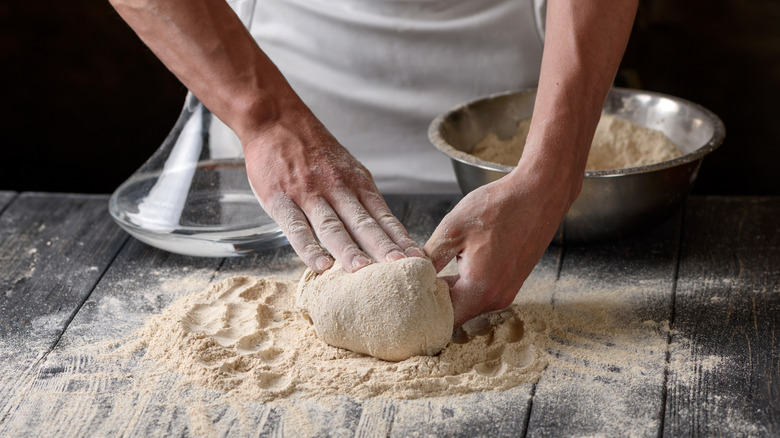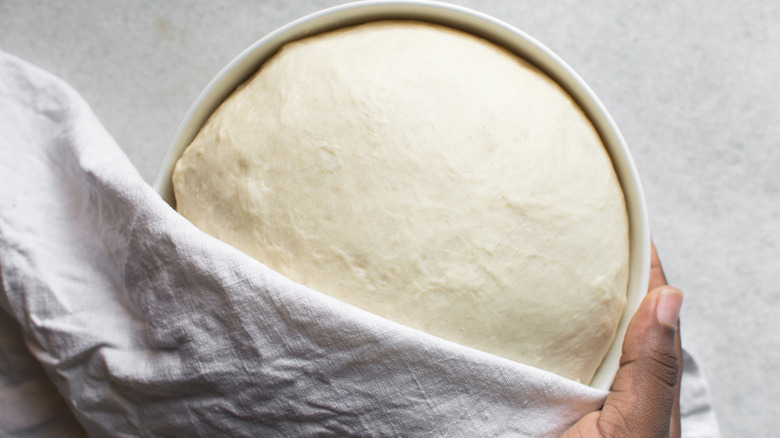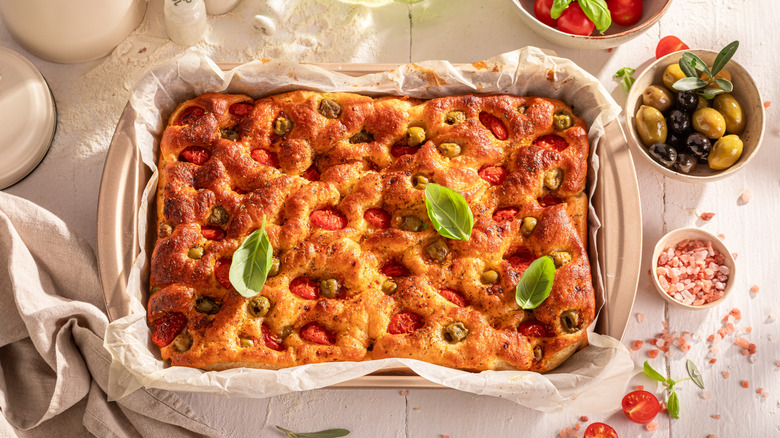The Yeast To Flour Ratio You Should Know For The Best Bread
When baking bread at home, be it shokupan (a long-lasting fluffy bread also called Pai Bao) or a quintessential sourdough farm loaf, the ratio can make or break things. Baking with yeast can sometimes feel more like alchemy than science, but finding the right proportion to use doesn't have to be difficult. For some tips, Food Republic spoke to Sheena Otto, resident baker of Brooklyn's Park Slope farmers market. "The agreed upon standard amongst bakers is 2%," she told us. "[S]o if your recipe contains 1,000g (1kg) of flour, you'd want to use 20g (.020kg) of yeast."
Why does this ratio work? Otto informed us that "[a]dding too much yeast can be an issue because you need the gluten network to develop sufficiently before the yeast activates and starts producing gas. ... [otherwise], there won't be anything to trap the gasses and leaven the dough." Though it might seem like a small amount of yeast to use, adding so little is, scientifically, more beneficial.
When yeast is added to bread dough, which is then allowed to proof, it releases gas (in the form of carbon dioxide) and alcohol. When released too quickly, and in excessive quantities, the gas and alcohol can weaken the gluten in the dough. To avoid this, a small quantity of yeast is usually better: It'll lead to a slower rise which will strengthen the gluten, creating a nicely structured crumb and helping the bread hold up better to baking. It'll take time, sure, but the results are well worth the wait. The key to successful bread making is patience, after all! It's worth noting that this ratio applies to fresh yeast -– use a ratio of 1% for dried yeast and 1.4% for fast-acting yeast.
That ratio isn't necessarily the same for every type of bread
You might be wondering if that golden ratio of 2% yeast to flour is a "one size fits all" solution — but beware, it isn't. The ideal ratio to use will change for almost every type of bread dough. "For doughs that are enriched with fats and sugars (like a brioche or a challah) [that] also contain sugar, you could go up to 3% yeast," Sheena Otto told us. This is because the sugar in the dough dissolves, meaning that there's less water available for the yeast to soak up — more water means more yeast fermentation, which is necessary for good bread. While this slows the rise down (which, remember, is good) you'll want to add a little more yeast than you would otherwise to make sure that it rises fully. That goes for whole loaves, or smaller options, like brioche burger buns or onion challah rolls.
What about that most coveted of homemade bread, the iconic artisan-style sourdough? These can be a little more difficult to gauge when it comes to the yeast-to-flour ratio. "For doughs that also contain a sourdough starter, where you can't really measure how much leavener is in the starter (unlike a sponge, which contains yeast, so you can calculate your percentages), I would go down to 1% or less," Otto noted. Better to be safe than sorry, then. True sourdough is particularly unique, as it doesn't actually require any added yeast at all, as your starter will have a natural leavener abundance.
What happens if you use too much yeast in your dough?
Though these ratios are a great way to make sure you get consistent results when baking at home, they're not exactly steadfast rules. We asked Sheena Otto what would happen if we were to use other ratios. "These are just guidelines," she told us, "if you want to get a focaccia on the table NOW for dinner, you can certainly go up to 4% yeast." More yeast will mean a faster release of gas and a quicker rise. If you want to spruce up that focaccia with, for example, cherry tomatoes, or make a focaccia stuffed with taleggio and pancetta, keep in mind that you may have to adjust the ratio of flour to yeast accordingly: Onions and balsamic vinegar, for example, have a high sugar content, so you may want to add slightly more yeast to your dough than normal to account for that excess.
You can use less yeast, if you like, too. "If you want to leave the dough at room temp for an extended amount of time, you can go down to ¼%," Otto clarified -– remember, this will lead to a slower rise, which can help really develop the gluten in your dough and ensure a great crumb. Though the rules are flexible, bear in mind that adjusting them will affect the quality of your final product. You don't want to use too much yeast, for example: It all comes back to that goal of allowing your bread to rise slowly.



